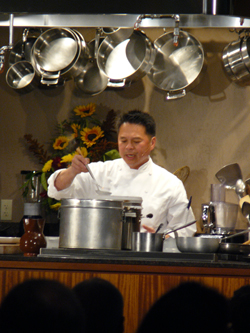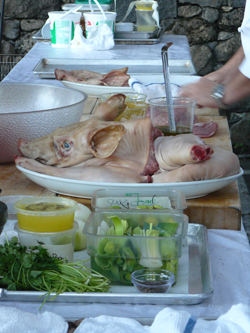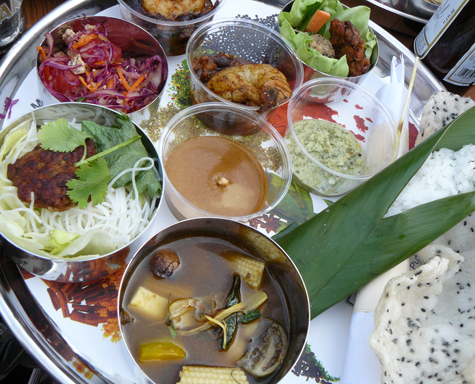Foie gras and fine dining are in retreat and casual enjoyment of bold flavors from around the globe are on the rise. That was the mega trend that wove together the innumerable sessions at this year’s World of Flavors conference held at the Culinary Institute of America at Greystone in Napa. Given the popularity of tapas menus, you may think that that’s no major pronouncement, but there has been a shift. Greg Drescher, creator of the CIA conference, noted that there’s been an acceleration of the trend in recent times due to America’s economic slow-down. The engine has been reved up as American diners remain enthralled with eating out but they want to pay less and experience foods that represent all the nooks and crannies of the world’s casual kitchens – whether that’s a hawker stall in Asia or the home kitchen in Tunisia. People are interested in a head-to-tail rigor when it comes to ingredients like fish and pork. (Finally!)
There were 700 people at the sold-out conference, an annual gathering of renowned chefs, researchers, authors and food industry leaders from all over the globe, and we were there to taste, talk and think about America’s changing culinary landscape. Our Saturday lunch, pictured above, was comprised of street food nibbles from throughout Asia. The colors and textures reflect America’s willingness to expand its palate.
Goodbye Fancy Feasts: Hello D.A.D.D.Y.
Dr. Tim Ryan, president of the CIA, framed the shift in American dinning as being a democratization process. White table clothed dining with stiff wait staff is being supplanted by taco trucks, counters and small plates. He described American dinners with this acronym – D.A.D.D.Y:
Despite what you may think, his set of terms sums up the multitasking, connected, sophisticated and over-stimulated faction of American society that’s into eating out and want things convenient, snappy, but delicious. Street foods such as Singaporean char kway teow wok-seared noodles and banh mi sandwiches fit the bill, and so do simple, soul-satisfying homey foods such as stews and barbecue spare ribs.
Chef Responses: Flavorful and Down-to-Earth
The innumerable tastings during the World of Flavors conference, whether it be in the marketplace walk-around or in the kitchen workshops and lectures were uncommonly good. In years past, there was an abundance of rich foods, such as lamb chops galore, but recessionary dining brought out delicious preparations of cassava (yuca, manioc), beans, and chard along with dishes featuring ground and minced meat. Here’s a small sampling of what Asian chefs offered:
- Mohan Ismail of Rocksugar – Nonya seafood laksa soup based on his mother’s recipe
- Bobby Chin of Restaurant Bobby Chin – Smoked pork belly tinged with caramel sauce was a clever riff on traditional Vietnamese kho
- Alex Ong of Betelnut – Tamarind-raisin glazed chicken wings proved that raisins can be used for the sweet sour edge in Southeast Asian cooking
- William Wongso – Potent beef rendang from Indonesia
- Violet Oon – Contemporary beef rendang sliders had rendang seasoning mixed into the meat
- Masaharu Morimoto – Okonomiyaki, takoyaki, and kare-pan are casual opposite to what Morimoto prepares at Morimoto restaurant an on Iron Chef America
- Mai Pham of Lemongrass – Bun bo hue noodle soup proved that it’s time to add a new Vietnamese noodle soup to the American table
- Charles Phan of Slanted Door – Fried rice cakes with bean sprouts (bot chien) and steamed rice rolls (banh cuon) paid tribute to Vietnam’s resourceful street vendors
- Kobkaew and Ning Naipinij of Khao Cooking School – deep-fried water spinach, rice noodles, and Thai chili jam highlighted that Thai food doesn’t have to be spicy hot to be brilliant
- Christine Manfield of Universal – fried tofu atop eggplant chili jam made for such a good breakfast that I had a second round
- Roy Choi of Kogi BBQ – Post-modern tacos reflecting the vibrant tastes and culture of Los Angeles
As you can see, the dishes were not of the fancy nor pricey type. The above photo is of our Saturday lunch; there were also veal cheek and chicken satay hot off the grill. All the foods offered at the conference were accessible, fun and flavorful dishes that you’d want to eat over and over again. That’s what we’re all looking to savor these days.
Writers and Critics: Last Words
The chef demos at World of Flavors were speedy like a Food Network show, but what gave their performances context were the talks that the food writers and authors offered. Several people made their points through photos. John T. Edge used his slide show of taco trucks and food stands all over the United States to demonstrate that the street food movement was not only an East Coast and West Coast phenomenon. Through images from Central Asia and beyond, Naomi Duguid encourage the nation’s food and beverage executives to incorporate ‘exotic’ dishes such as Yunnan noodles into their menus. Such foods tap into people’s desires for personalizing food. “You can select your noodles, toppings and broth. It’s all about choice and would be perfect at universities,” she said. Chef and researcher Maricel Presilla shared photos and strategies on how she planned and executed a pan-Asian dinner at the White House last month.
Other writers opted for just words. Pulitzer prize-winning writer Jonathan Gold of the LA Weekly declared that America is in the midst of a street food renaissance. He cited the amazing lunch-time offering along the Miracle Mile in Los Angeles as an example. Professor Jessica Harris of Queens College channeled Captain Kirk of Star Trek when she proclaimed that Africa was the last frontier, that it should be mined and explored for it culinary impact on the United States. “Creolized cooking gave rise to composed rice dishes,” Dr. Harris reminded us.
Esteemed food and restaurant authority Ruth Reichl offered a 30-year retrospective on the American dining scene, citing Alice Waters’ Chez Panisse Cafe, Wolfgang Puck’s Spago and Chinois on Main, Philip Chiang’s Mandarette, and Grant Achatz’s Alinea as the major game changes that have redefined what and how we eat. Reichl noted that in the past, “America had not been a food culture. Now the United Stated is a food society.” Food television and a raging appetite for culinary excitement facilitated that change. She mentioned that shops such as Kalustyan’s in Manhattan have practically all the ‘exotic’ ingredients that she encountered while filming Adventures with Ruth. They’re not as inaccessible as they once were. Not so exotic anymore.
“How do you make your restaurant exciting in a world where you can find everything?” she challenged the audience of chefs, restaurateurs, and food and beverage executives. That’s the million dollar question, and World of Flavors 2009 offered many potential solutions.
How do you see America’s palate changing? Are people really more open to flavors such as fish sauce or is it just limited to a small group of food enthusiasts? What should be our benchmarks for gauging America’s readiness for bold flavors? Durian?




















Jai says
The exposure of food and cuisine on both television and the internet has stimulated not only the American palate but the worlds' palate. Look at the explosion of food blogs online and the popularity of TV shows like No Reservations, Bizarre Foods and Iron chef. It will be a slow process but Americans are looking for healthy and inexpensive ways to feed their families. I'll never forget the first time I tried Durian. My Asian friends looked at me like I was crazy but I loved it. Being Italian, I use fish sauce in pasta sauces and salad dressings as opposed to anchovies. It's a matter of being creative and open-minded.
Andrea Nguyen says
Jai -- you're absolutely right! Sometimes we think that shows like Bizarre Foods hype the exotic and they kind of do -- but perhaps they also get the American eating and cooking public to expand their viewpoint!
Robyn says
Only one thing seemed out of place at the conference -- the veal cheeks for William Wongso's sate, an awfully expensive and 'precious' ingredient for street fare! They melted in the mouth, but as William observed the texture was all wrong: 'The beef should be chewy!" (But the texture of his wonderful beef rendang was just right!)
Nice round-up.
diyet says
Hi. This Article is very helpful for me..
Thank you very much..
Have good days friend.
Jim says
I have been trying to tell people for awhile now that th food landscape is undergoing massive change, as far as future trends are concerned. World food is the future of the food industry as the director of the CIA recently proclaimed. I have noticed, however, that as in most things, the change is occurring, for the time being at least, in the major population centers. I live in the Portland, OR area, but am visiting NJ to spend time with my family. Where they live, the street food renaissance is virtually non-existent, and the ethnic food is business as usual, meaning steam table Chinese and lots of Pizza. My nephews had never tasted fresh tacos until I made them some just last year! I visited New England over the weekend, and in the outlying areas, it was the same thing. Food carts and bold, world flavors were nowhere to be found. (Good thing I travel with several varieties of home made hot sauce!) I believe its going to happen, but will take some time, particularly among the older, suburban population, particularly in areas where food traditions are firmly entrenched. I'll keep doing my part to make it happen!
Andrea Nguyen says
Robyn -- Yeah, the veal cheeks were over cooked and William Wongso was right to demure. I wonder if buffalo or bison would have fared better?
Jim -- You're a good man to be traveling with hot sauce and spreading the news of big flavor. Gatherings such as World of Flavors help to set the tone and stage for what's to come. These are folks who put food on the American table so it's a few years out for the flavors and techniques to hit. There was a refreshing commingling of cultures. Your observation that parts of the U.S. are not in on the action is I suppose a business opportunity...!
r4 dsi says
Democratization in America is because of recession, a very big reason of recession has created this vast problem. not only in US but is adversely affecting all over the world.
marlon says
This Article is very helpful for me..
Thank you very much..
marlon says
The exposure of food and cuisine on both television and the internet has stimulated not only the American palate but the worlds' palate.